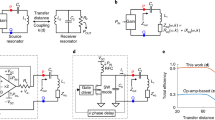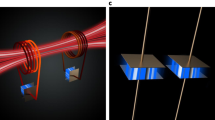Abstract
Considerable progress in wireless power transfer has been made in the realm of non-radiative transfer, which employs magnetic-field coupling in the near field1,2,3,4. A combination of circuit resonance and impedance transformation is often used to help to achieve efficient transfer of power over a predetermined distance of about the size of the resonators3,4. The development of non-radiative wireless power transfer has paved the way towards real-world applications such as wireless powering of implantable medical devices and wireless charging of stationary electric vehicles1,2,5,6,7,8. However, it remains a fundamental challenge to create a wireless power transfer system in which the transfer efficiency is robust against the variation of operating conditions. Here we propose theoretically and demonstrate experimentally that a parity–time-symmetric circuit incorporating a nonlinear gain saturation element provides robust wireless power transfer. Our results show that the transfer efficiency remains near unity over a distance variation of approximately one metre, without the need for any tuning. This is in contrast with conventional methods where high transfer efficiency can only be maintained by constantly tuning the frequency or the internal coupling parameters as the transfer distance or the relative orientation of the source and receiver units is varied. The use of a nonlinear parity–time-symmetric circuit should enable robust wireless power transfer to moving devices or vehicles9,10.
This is a preview of subscription content, access via your institution
Access options
Access Nature and 54 other Nature Portfolio journals
Get Nature+, our best-value online-access subscription
$29.99 / 30 days
cancel any time
Subscribe to this journal
Receive 51 print issues and online access
$199.00 per year
only $3.90 per issue
Buy this article
- Purchase on Springer Link
- Instant access to full article PDF
Prices may be subject to local taxes which are calculated during checkout



Similar content being viewed by others
References
Zierhofer, C. M. & Hochmair, E. S. High-efficiency coupling-insensitive transcutaneous power and data transmission via an inductive link. IEEE Trans. Biomed. Eng. 37, 716–722 (1990)
Troyk, P. R. & Schwan, M. A. Closed-loop class E transcutaneous power and data link for microimplants. Med. Biol. Eng. Comput. 39, 589–599 (1992)
Kurs, A. et al. Wireless power transfer via strongly coupled magnetic resonances. Science 317, 83–86 (2007)
Yu, X. et al. Wireless power transfer in the presence of metallic plates: experimental results. AIP Adv. 3, 062102 (2013)
Heetderks, W. J. RF powering of millimeter- and submillimeter-sized neural prosthetic implants. IEEE Trans. Biomed. Eng. 35, 323–327 (1988)
Villa, J. L., Sallán, J., Llombart, A. & Sanz, J. F. Design of a high frequency inductively coupled power transfer system for electric vehicle battery charge. Appl. Energy 86, 355–363 (2009)
Huh, J., Lee, S. W., Lee, W. Y., Cho, G. H. & Rim, C. T. Narrow-width inductive power transfer system for online electrical vehicles. IEEE Trans. Power Electron. 26, 3666–3679 (2011)
Ho, J. S. et al. Wireless power transfer to deep-tissue microimplants. Proc. Natl Acad. Sci. USA 111, 7974–7979 (2014)
Brecher, A. & Arthur, D. Review and Evaluation of Wireless Power Transfer (WPT) for Electric Transit Applications. FTA Report No. 0060, https://www.transit.dot.gov/sites/fta.dot.gov/files/FTA_Report_No._0060.pdf (US Department of Transportation, Federal Transit Administration, 2014)
Li, S. & Mi, C. C. Wireless power transfer for electric vehicle applications. IEEE J. Emerg. Select. Topics Power Electronics 3, 4–17 (2015)
Tesla, N. Apparatus for transmitting electrical energy. US patent 1,119,732 (1914)
Brown, W. C. The history of power transmission by radio waves. IEEE Trans. Microw. Theory Tech. 32, 1230–1242 (1984)
Sample, A. P., Meyer, D. A. & Smith, J. R. Analysis, experimental results, and range adaptation of magnetically coupled resonators for wireless power transfer. IEEE Trans. Ind. Electron. 58, 544–554 (2011)
Bender, C. M. & Boettcher, S. Real spectra in non-Hermitian Hamiltonians having PT-symmetry. Phys. Rev. Lett. 80, 5243–5246 (1998)
Bender, C. M., Brody, D. C. & Jones, H. F. Complex extension of quantum mechanics. Phys. Rev. Lett. 89, 270401 (2002)
Guo, A. et al. Observation of PT-symmetry breaking in complex optical potentials. Phys. Rev. Lett. 103, 093902 (2009)
Rüter, C. E. et al. Observation of parity–time symmetry in optics. Nat. Phys. 6, 192–195 (2010)
Makris, K. G., El-Ganainy, R., Christodoulides, D. N. & Musslimani, Z. H. Beam dynamics in PT symmetric optical lattices. Phys. Rev. Lett. 100, 103904 (2008)
Lin, Z. et al. Unidirectional invisibility induced by PT-symmetric periodic structures. Phys. Rev. Lett. 106, 213901 (2011)
Peng, B. et al. Parity–time-symmetric whispering-gallery microcavities. Nat. Phys. 10, 394 (2014)
Liertzer, M. et al. Pump-induced exceptional points in lasers. Phys. Rev. Lett. 108, 173901 (2012)
Feng, L., Wong, Z. J., Ma, R.-M., Wang, Y. & Zhang, X. Single-mode laser by parity-time symmetry breaking. Science 346, 972–975 (2014)
Hodaei, H., Miri, M.-A., Heinrich, M., Christodoulides, D. N. & Khajavikhan, M. Parity–time-symmetric microring lasers. Science 346, 975 (2014)
Peng, B. et al. Loss-induced suppression and revival of lasing. Science 346, 328–332 (2014)
Hassan, A. U., Hodaei, H., Miri, M. A., Khajavikhan, M. & Christodoulides, D. N. Nonlinear reversal of the PT-symmetric phase transition in a system of coupled semiconductor microring resonators. Phys. Rev. A 92, 63807 (2015)
Ge, L. & El-Ganainy, R. Nonlinear modal interactions in parity-time (PT) symmetric lasers. Sci. Rep. 6, 24889 (2016)
Haus, H. A. Waves and Fields in Optoelectronics 197–228 (Prentice Hall, 1984)
Siegman, A. E. Lasers 992–996 (University Science Books, 1986)
Schindler, J. et al. PT-symmetric electronics. J. Phys. A 45, 444029 (2012)
Raab, F. H. et al. Power amplifiers and transmitters for RF and microwave. IEEE Trans. Microw. Theory Tech. 50, 814–826 (2002)
Cerjan, A. & Stone, A. D. Steady-state ab initio theory of lasers with injected signals. Phys. Rev. A 90, 013840 (2014)
Zhou, X. & Chong, Y. D. PT symmetry breaking and nonlinear optical isolation in coupled microcavities. Opt. Express 24, 6916 (2016)
Kim, N. Y., Kim, K. Y., Choi, J. & Kim, C.-W. Adaptive frequency with power-level tracking system for efficient magnetic resonance wireless power transfer. Electron. Lett. 48, 452 (2012)
Shin, J. et al. Design and implementation of shaped magnetic-resonance-based wireless power transfer system for roadway-powered moving electric vehicles. IEEE Trans. Ind. Electron. 61, 1179–1192 (2014)
Acknowledgements
Part of the work was supported by the TomKat Center for Sustainable Energy at Stanford. S.F. thanks R. Sassoon and A. Cerjan for discussions.
Author information
Authors and Affiliations
Contributions
S.A. performed the simulations and experiment. All authors contributed to formulating the analytical model, to analysing the data, and to writing the manuscript. S.F. initiated and supervised the project.
Corresponding author
Ethics declarations
Competing interests
The authors declare no competing financial interests.
Additional information
Reviewer Information Nature thanks Y. Chong and G. Lerosey for their contribution to the peer review of this work.
Publisher's note: Springer Nature remains neutral with regard to jurisdictional claims in published maps and institutional affiliations.
Extended data figures and tables
Extended Data Figure 1 Stability analysis for the steady-state solution with the lowest gain.
a, Lyapunov exponents are of the decaying type, showing that the steady-state solution with the lowest gain is stable for all transfer distances. At the PT transition point, the eigenmodes coalesce, resulting in marginal stability along with frequency bifurcation, which has no effect on the transfer efficiency. The coupling rates are extracted from our experimental setup and ω1 = ω2 = 1, γ10 = 5 × 10−4, γ2 = 0.013. b, Lyapunov exponents versus resonator detuning at the PT transition point. The marginal stability disappears with non-zero resonator detuning.
Extended Data Figure 2 Simulated transient response to sudden movements of the receiver.
Effect of sudden changes in the separation distance (top panels) on the mode amplitudes a1,2 (bottom panels). a, For a sudden shift in the separation distance between 75 cm and 65 cm, the nonlinear PT power transfer system settles into its steady state within 50 μs. The move across the PT phase transition point represents the worst case for the transient decay time. b, The transient response becomes shorter away from the PT phase transition. Here, a sudden shift in distance from 65 cm to 55 cm results in less than 25 μs of transient decay time. The inset (same axes as the main panel) shows a magnified transient response at around 250 μs. These transient response times are much shorter than the typical timescale of mechanical motions, demonstrating the viability of our proposed system for dynamic wireless power transfer. The simulations are performed by solving equation (6) in the time domain using the coupling rates extracted from the experimental setup and other pertinent parameters as follows: ω1 = ω2 = 2π × 2.50 MHz, γ10 = 2π × 1.25 kHz, γ2 = 2π × 32.5 kHz, and 
Extended Data Figure 3 Tolerance to resonator detuning.
The transfer efficiency (equation (5)) is plotted as the receiver’s resonant frequency ω2 is detuned away from that of the source ω1. The range of acceptable detuning is limited to around the receiver’s linewidth γ2. The same limit also applies to other forms of resonant power transfer. The coupling rates are extracted from our experimental setup, ω1 = 1, γ10 = γ20 = 5 × 10−4 and γ2 = 0.013.
Extended Data Figure 4 Steady-state frequency as a function of unsaturated gain value.
The unsaturated gain rate is adjusted via resistor R1 in the circuit simulation with other circuit parameters fixed (Extended Data Table 1). The mode frequency remains largely unchanged as the source resonator’s unsaturated gain g1 is increased from near its required minimum value, g0, to 2g0. The only mode switching observed occurs at g1 = 2g0, near the transfer distance of 70 cm, where the system crosses the PT transition point. Since both frequency branches offer identical performance when the source’s and receiver’s resonances are tuned, the effect of mode switching to the other branch on the system performance here is minimal.
Extended Data Figure 5 Coupling rate as a function of separation distance.
a, Coil dimensions for the coupling rate calculation (equations (8)–(10)) are as follows: w = 0.25 mm, l = 2.54 cm and 2r = 58 cm. b, Comparison of the calculated and experimental values of the coupling rate as a function of the separation between the two coaxially aligned coils.
Supplementary information
Demonstration of the PT symmetric scheme in a dynamic wireless power transfer scenario.
Robust power transfer is achieved by the virtue of PT symmetry in saturation as shown by the constant brightness of the LED bulb when the receiver is moved to and from the source. (MP4 23148 kb)
Demonstration of the conventional scheme in a dynamic wireless power transfer scenario.
The transferred power level is dependent on the source-to-receiver separation distance as shown by the variation of the LED brightness as the receiver is moved to and from the source. (MP4 22482 kb)
Rights and permissions
About this article
Cite this article
Assawaworrarit, S., Yu, X. & Fan, S. Robust wireless power transfer using a nonlinear parity–time-symmetric circuit. Nature 546, 387–390 (2017). https://doi.org/10.1038/nature22404
Received:
Accepted:
Published:
Issue Date:
DOI: https://doi.org/10.1038/nature22404
This article is cited by
-
Exceptional points enhance sensing in silicon micromechanical resonators
Microsystems & Nanoengineering (2024)
-
Enhanced sensitivity with nonlinearity-induced exceptional points degeneracy lifting
Communications Physics (2024)
-
Wireless power and information dual transfer system via magnetically coupled resonators
Communications Engineering (2024)
-
Intelligent wireless power transfer via a 2-bit compact reconfigurable transmissive-metasurface-based router
Nature Communications (2024)
-
Frequency-hopping wave engineering with metasurfaces
Nature Communications (2024)
Comments
By submitting a comment you agree to abide by our Terms and Community Guidelines. If you find something abusive or that does not comply with our terms or guidelines please flag it as inappropriate.



